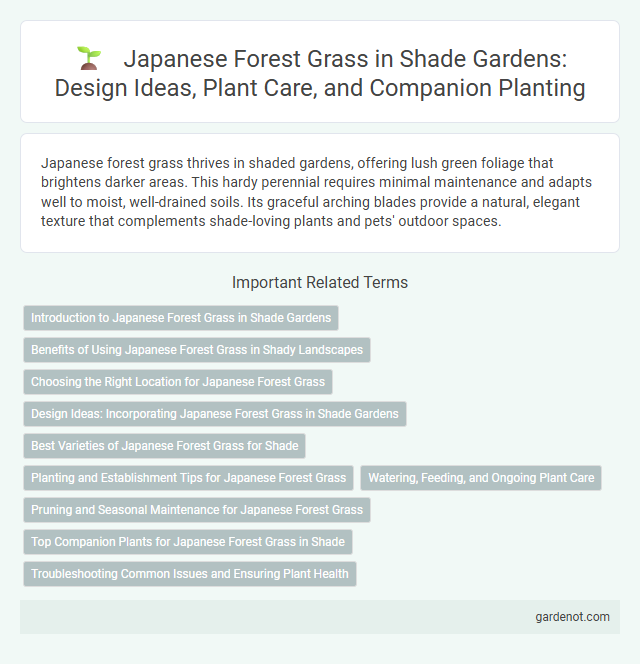Japanese forest grass thrives in shaded gardens, offering lush green foliage that brightens darker areas. This hardy perennial requires minimal maintenance and adapts well to moist, well-drained soils. Its graceful arching blades provide a natural, elegant texture that complements shade-loving plants and pets' outdoor spaces.
Introduction to Japanese Forest Grass in Shade Gardens
Japanese forest grass (Hakonechloa macra) is an elegant, shade-loving perennial renowned for its graceful, arching foliage that adds texture and movement to shade gardens. Thriving in partial to full shade, this compact ornamental grass offers vibrant green hues that often turn golden or red in autumn, enhancing year-round garden interest. Its low maintenance and adaptability make it an ideal choice for understory planting beneath trees or in shaded borders, promoting biodiversity and soil health.
Benefits of Using Japanese Forest Grass in Shady Landscapes
Japanese forest grass (Hakonechloa macra) thrives in shaded landscapes, offering vibrant, cascading foliage that enhances garden texture and color contrast. Its tolerance to low light and adaptability to moist, well-drained soils reduce maintenance needs while preventing soil erosion under tree canopies. This ornamental grass promotes biodiversity by providing habitat for beneficial insects, improving overall ecosystem health in shade gardens.
Choosing the Right Location for Japanese Forest Grass
Japanese forest grass (Hakonechloa macra) thrives in shaded or partially shaded locations, making it an ideal choice for shade gardens. Selecting a site with well-drained, moist, and humus-rich soil enhances its vibrant foliage and graceful, arching form. Avoid areas with direct, harsh sunlight or overly dry conditions to ensure optimal growth and longevity.
Design Ideas: Incorporating Japanese Forest Grass in Shade Gardens
Japanese forest grass (Hakonechloa macra) enhances shade garden design with its graceful, arching foliage that adds texture and movement to dimly lit areas. Combining this ornamental grass with ferns, hostas, and astilbes creates layered, visually rich compositions that thrive in low-light conditions. Its vibrant chartreuse and golden varieties provide natural contrast, making it a versatile choice for softening hardscape edges and pathways in shaded landscapes.
Best Varieties of Japanese Forest Grass for Shade
Hakonechloa macra, commonly known as Japanese Forest Grass, thrives in shaded garden areas due to its preference for moist, well-drained soil and dappled sunlight. Top varieties for shade include 'Aureola,' known for its vibrant yellow and green striped leaves, and 'All Gold,' prized for its bright golden foliage that brightens dark garden corners. These cultivars provide excellent ground cover and texture, enhancing the aesthetic appeal of shaded landscapes.
Planting and Establishment Tips for Japanese Forest Grass
Japanese Forest Grass (Hakonechloa macra) thrives in well-drained, humus-rich soil with consistent moisture to support its delicate root system. Plant in partial to full shade to mimic its native woodland environment, ensuring protection from harsh afternoon sun that can scorch foliage. Mulching helps retain soil moisture and regulates temperature, promoting healthy establishment during the first growing season.
Watering, Feeding, and Ongoing Plant Care
Japanese forest grass thrives in consistently moist, well-drained soil, requiring regular watering especially during dry spells to maintain its lush appearance. Apply a balanced, slow-release fertilizer in spring to promote healthy growth and vibrant foliage. Ongoing care includes removing dead leaves, dividing clumps every few years to prevent overcrowding, and mulching to retain moisture and suppress weeds.
Pruning and Seasonal Maintenance for Japanese Forest Grass
Pruning Japanese forest grass (Hakonechloa macra) involves trimming back dead or damaged foliage in early spring to promote healthy new growth and maintain its graceful form. Seasonal maintenance requires removing yellowing or brown leaves during the growing season to enhance air circulation and prevent fungal diseases. Dividing the clumps every 3 to 4 years in early spring helps rejuvenate the plant and encourages vigorous growth in shade garden settings.
Top Companion Plants for Japanese Forest Grass in Shade
Japanese forest grass (Hakonechloa macra) thrives in shaded garden areas and pairs beautifully with shade-loving companions like hostas, ferns, and astilbes to create lush, textured landscapes. Ferns such as Japanese painted fern and lady fern complement its graceful arching leaves with contrasting foliage textures and shades of green. Astilbes add vibrant flower spikes that enhance the garden's visual interest, while hostas provide broad leaves that contrast well with Japanese forest grass's delicate blades.
Troubleshooting Common Issues and Ensuring Plant Health
Japanese forest grass (Hakonechloa macra) often faces common issues such as yellowing leaves caused by overwatering or poor drainage, which can be mitigated by ensuring well-drained soil and moderate moisture levels. To prevent fungal diseases like leaf spot, maintaining good air circulation and removing affected foliage promptly is essential. Regularly checking for pests such as slugs and snails helps protect plant health and promotes vibrant growth in shaded garden areas.
Japanese forest grass Infographic

 gardenot.com
gardenot.com